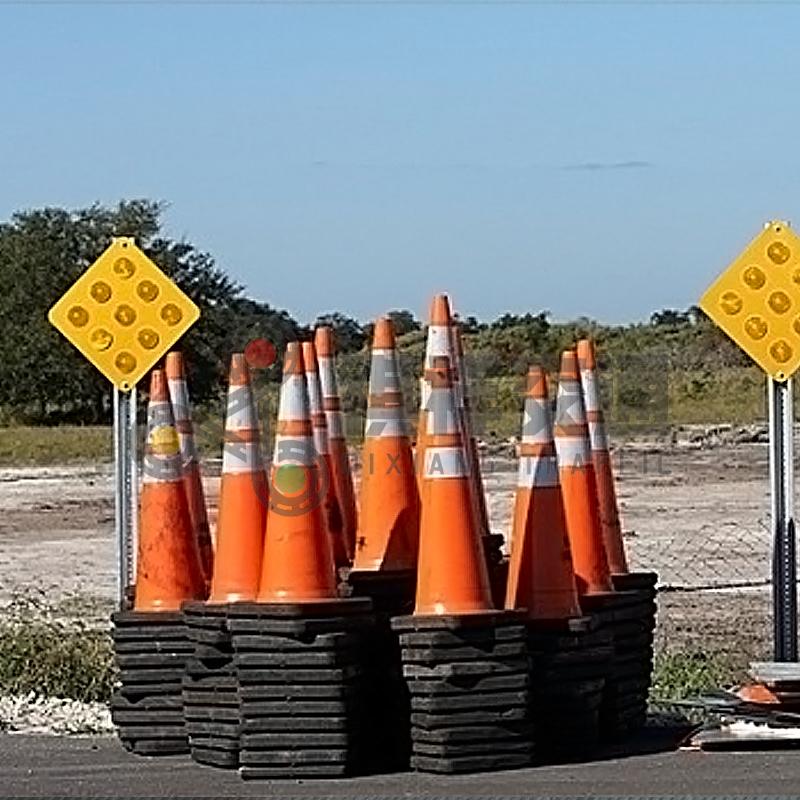Traffic cones are ubiquitous on roads, construction sites, and event venues, serving as essential tools for traffic management and safety. While their bright colors and reflective strips are easily recognizable, the materials used to manufacture these cones are often overlooked. Understanding the material composition of traffic cones is crucial for selecting the right type for specific applications, ensuring durability, visibility, and safety. This article delves into the various materials used in the production of traffic cones, their properties, and their suitability for different environments.
Common Materials Used in Traffic Cones
1.Polyvinyl Chloride (PVC)
PVC is one of the most commonly used materials for traffic cones. Known for its flexibility and durability, PVC can withstand a wide range of temperatures and weather conditions. This material is also resistant to UV rays, which helps maintain the cone’s bright color over time. PVC traffic cones are often used in urban areas and on highways due to their ability to endure heavy traffic and harsh environmental conditions.
2. Rubber
Rubber traffic cones are another popular choice, especially in areas where impact resistance is crucial. Rubber cones are highly flexible and can return to their original shape after being run over by vehicles. This material is also slip-resistant, making it ideal for use on wet or icy surfaces. Rubber traffic cones are commonly found in parking lots, construction sites, and areas with heavy machinery.
3. Polyethylene (PE)
Polyethylene is a lightweight and cost-effective material used in the production of traffic cones. PE cones are easy to transport and set up, making them suitable for temporary events and short-term projects. However, they may not be as durable as PVC or rubber cones and are more susceptible to damage from UV exposure and extreme temperatures. Despite these limitations, PE traffic cones are widely used for crowd control and event management.
4. Ethylene Vinyl Acetate (EVA)
EVA is a type of plastic known for its elasticity and toughness. Traffic cones made from EVA are lightweight yet durable, offering a good balance between flexibility and rigidity. EVA cones are often used in sports events, schools, and recreational areas where the risk of vehicle impact is lower. Their lightweight nature also makes them easy to handle and store.
5. Recycled Materials
In recent years, there has been a growing emphasis on sustainability, leading to the production of traffic cones from recycled materials. These cones are typically made from a combination of recycled rubber, plastics, and other materials. While they may not offer the same level of durability as cones made from virgin materials, they are an eco-friendly option that helps reduce waste and promote environmental conservation.
Factors to Consider When Choosing Traffic Cone Material
1. Durability
The durability of a traffic cone is a critical factor, especially in high-traffic areas or harsh weather conditions. PVC and rubber cones are generally more durable and can withstand repeated impacts and exposure to the elements. For long-term use, investing in high-quality, durable cones is essential.
2. Visibility
Visibility is another crucial aspect, as traffic cones are primarily used to alert drivers and pedestrians to potential hazards. Materials that can hold bright colors and support reflective strips, such as PVC and PE, are ideal for ensuring maximum visibility both day and night.
3. Flexibility
Flexibility is important for traffic cones that may be subject to impact from vehicles or machinery. Rubber and EVA cones offer excellent flexibility, allowing them to bend and return to their original shape without breaking. This property is particularly useful in construction zones and parking areas.
4. Weight
The weight of a traffic cone can affect its stability and ease of transport. Heavier cones, such as those made from rubber, are less likely to be blown over by wind or displaced by passing vehicles. However, lighter cones made from PE or EVA are easier to move and set up, making them suitable for temporary or short-term use.
5. Environmental Impact
With increasing awareness of environmental issues, the use of recycled materials in traffic cone production is becoming more common. While these cones may not always match the performance of those made from virgin materials, they offer a sustainable alternative that helps reduce waste and conserve resources.
Conclusion
The material composition of traffic cones plays a significant role in their performance, durability, and suitability for various applications. PVC, rubber, polyethylene, EVA, and recycled materials each offer unique properties that make them ideal for specific environments and uses. By understanding the advantages and limitations of each material, users can make informed decisions when selecting traffic cones, ensuring optimal safety and efficiency in traffic management and control.
Whether for long-term use on highways or temporary deployment at events, choosing the right material for traffic cones is essential for maintaining safety and visibility. As technology and materials science continue to advance, we can expect further innovations in the design and production of traffic cones, enhancing their effectiveness and sustainability in the years to come.
If you need road safety equipments, please feel free to contact traffic cones supplier Qixiang for more information.
Post time: Sep-14-2024







